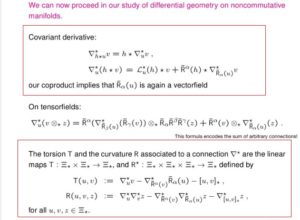One of the deepest result in quantum physics is that the Wave-Particle-Duality-Relations correspond to a modern formulation of the Heisenberg uncertainty principle stated in terms of entanglement entropies: a Bell-type argument in the context of T-duality’s winding modes, shows the action describing any particle implies an ontological non-locality intrinsic to the notion of ‘particle’ and in this series of posts, I will show how that entails that ‘non-local-particles‘ (Pages 51-67) can be symmetrically identified with strings in string-theory. Consider, as I showed, the non-commutative action for the dynamics of N-branes of type ![]() in the string regime:
in the string regime:
with the D-1-action:
![Rendered by QuickLaTeX.com \[S_1^D = {\mkern 1mu} - {T_1}\int\limits_{{\rm{worldvolumes}}} {{d^{1 + 1}}} \xi \frac{{\not D_{\mu \nu }^{susy}L}}{{{{\not \partial }_{{v_a}}}}}{e^{ - {\Phi _{bos}}}}{\rm{de}}{{\rm{t}}^{1/2}}G_{ab}^{\exp \left( {H_{1 + 1}^{{\rm{array}}}} \right)}\]](https://www.georgeshiber.com/wp-content/ql-cache/quicklatex.com-419daa2cd761b73dc40dd86727fa8ee8_l3.png)
and we get from:
![]()
the d-1 mass-term:
![Rendered by QuickLaTeX.com \[{T_1}{e^{ - {\Phi _{bos}}}}\prod\limits_{i = 1}^1 {\left( {2\pi nR} \right)} \]](https://www.georgeshiber.com/wp-content/ql-cache/quicklatex.com-086906656c205d57cb4cb1fc756336b3_l3.png)
noting that generalizations to fields and D/p-branes are straightforward. In this, part one, I will draw a summary showing that non-local particle-theory with conformal symmetry is characterized by its spectrum ![]() in string-theory.
in string-theory.
Nonlocal actions of particles derived via Feynman integral decomposition on a conformal hypersurface with conformal symmetry gives us a Virasoro algebra as guaranteed by Noether’s theorem
Let us look at what string-theory says about their canonical quantization
Consider quadratic actions of the form:
![]()
with scalar fields ![]() and
and ![]() . A canonical quantization yields the variational action:
. A canonical quantization yields the variational action:
![Rendered by QuickLaTeX.com \[\begin{array}{l}\delta {S^q} = \int {dt\left\{ {\delta x\left[ {f\left( {{{\not \partial }_t}} \right)y\left( t \right)} \right]} \right.} + \\\delta y\left( t \right)\left[ {f\left( { - {{\not \partial }_t}} \right)x\left( t \right)} \right] + x\left( t \right)\left[ {f\left( {{{\not \partial }_t}} \right)\delta y\left( t \right)} \right] - \\\left. {\left[ {f\left( { - {{\not \partial }_t}} \right)x\left( t \right)} \right]\delta y\left( t \right)} \right\}\end{array}\]](https://www.georgeshiber.com/wp-content/ql-cache/quicklatex.com-8192d79ecd2d4ef79cad728b13a825e6_l3.png)
with equations of motion:
![]()
Solving for ![]() and
and ![]() gives the following solutions:
gives the following solutions:
![]()
and
![]()
with  being the set of zeros of
being the set of zeros of  :
:
![]()
Thus, the total derivative of
![Rendered by QuickLaTeX.com \[\begin{array}{l}\delta {S^q} = \int {dt\left\{ {\delta x\left[ {f\left( {{{\not \partial }_t}} \right)y\left( t \right)} \right]} \right.} + \\\delta y\left( t \right)\left[ {f\left( { - {{\not \partial }_t}} \right)x\left( t \right)} \right] + x\left( t \right)\left[ {f\left( {{{\not \partial }_t}} \right)\delta y\left( t \right)} \right] - \\\left. {\left[ {f\left( { - {{\not \partial }_t}} \right)x\left( t \right)} \right]\delta y\left( t \right)} \right\}\end{array}\]](https://www.georgeshiber.com/wp-content/ql-cache/quicklatex.com-8192d79ecd2d4ef79cad728b13a825e6_l3.png)
is:
![]()
where ![]() is:
is:
![]()
with
![]()
So we get a Taylor expansion:
![]()
with the sympletic two-form
![]()
being:
![Rendered by QuickLaTeX.com \[\begin{array}{l}\omega = \bullet \left( {\frac{{1 \otimes f\left( {{{\not \partial }_t}} \right) - f\left( { - {{\not \partial }_t}} \right) \otimes 1}}{{1 \otimes {{\not \partial }_t} + {{\not \partial }_t} \otimes 1}}} \right)\left( {x\left( t \right) \otimes \delta y\left( t \right)} \right)\\ = \sum\limits_{n = 0}^\infty {{f_n}} \left\{ { \bullet \sum\limits_{k = 1}^n {\left[ {{{\left( { - {{\not \partial }_t}} \right)}^{k - 1}} \otimes \not \partial _t^{n - k}} \right]\left( {\delta x\left( t \right) \otimes \delta y\left( t \right)} \right)} } \right\}\end{array}\]](https://www.georgeshiber.com/wp-content/ql-cache/quicklatex.com-8fb3d0178ac4692f5472f1e39a77ca5b_l3.png)
Since all zeros of  are non-degenerate, we get:
are non-degenerate, we get:
![]()
Now, there are nonlocal particle actions satisfying conformal symmetry as a realized symmetry of string-theory worldline reparametrization
![]()
In the harmonic basis:
![]()
![]() being complex conjugation and
being complex conjugation and ![]() the infinitesimal transformation of
the infinitesimal transformation of ![]() generated by the differential operator:
generated by the differential operator:
![]()
and this is the crucial point: it satisfies the Virasoro algebra
![]()
Now, compactifying ![]() on a circle, I can normalize
on a circle, I can normalize ![]() so that
so that ![]() , thus
, thus ![]() constitutes a complete basis for functions of
constitutes a complete basis for functions of ![]() and the Virasoro algebra is equivalent to the full reparametrization symmetry of
and the Virasoro algebra is equivalent to the full reparametrization symmetry of ![]() .
.
Hence, a length scale is injected corresponding to the shift  in
in  that normalizes to
that normalizes to  , with the Virasoro algebra generators constraining the normalization, the non-locality of particles has the gauge symmetry of the conformal group intrinsic to string theory
, with the Virasoro algebra generators constraining the normalization, the non-locality of particles has the gauge symmetry of the conformal group intrinsic to string theory
Solving, we get the equations of motion:
![Rendered by QuickLaTeX.com \[\left\{ {\begin{array}{*{20}{c}}{x\left( t \right)\sum\limits_{k \in \not {\rm Z}} {{x_k}{e^{ - ikt}}} }\\{y\left( t \right)\sum\limits_{k \in \not {\rm Z}} {{y_k}{e^{ - ikt}}} }\end{array}} \right.\]](https://www.georgeshiber.com/wp-content/ql-cache/quicklatex.com-c2591b5cd062437aaf3f054f7eb395b7_l3.png)
If ![]() is symmetric, we have
is symmetric, we have
![]()
and ![]() always comes in pairs
always comes in pairs ![]() except for
except for ![]() or
or ![]() . Hence, the symplectic two-form:
. Hence, the symplectic two-form:
![]()
becomes:
![]()
with the conserved charges ![]() with
with ![]() ,
, ![]() given by the symmetry transformation:
given by the symmetry transformation:
![]()
with the creation/annihilation operators:
![Rendered by QuickLaTeX.com \[\left\{ {\begin{array}{*{20}{c}}{{a_{ - k}} = {{\left( {\dot f\left( {ik} \right)k} \right)}^{1/2}}{x_k}}\\{{b_k} = {{\left( {\dot f\left( {ik} \right)k} \right)}^{1/2}}{y_k}}\end{array}} \right.\]](https://www.georgeshiber.com/wp-content/ql-cache/quicklatex.com-0546dffb8af86542354399368be8245b_l3.png)
Therefore, the symplectic two-form is equivalent to
![]()
Important: the Virasoro algebraic constraints eliminate ghosts since the conserved charges are:
![]()
with:
![Rendered by QuickLaTeX.com \[B\left( {n,k} \right) = {\left( {\frac{{\dot f\left( {ik} \right)}}{{\dot f\left( {i\left( {k + n} \right)} \right)}}\frac{{k + n}}{k}} \right)^{1/2}}\]](https://www.georgeshiber.com/wp-content/ql-cache/quicklatex.com-362edc75ff8905c81226b7ca778443ac_l3.png)
with non-negative spectrum upon quantization after renormalization-ordering, and so the Virasoro algebra is satisfied at the semi-classical tree-level, as evidenced by:
![]()
with the following holding:
![]()
and since:
![]()
I can deduce:
![]()
Summary so far: for the action
![]()
non-local particle theory with conformal symmetry is characterized by its spectrum  in string-theory
in string-theory





